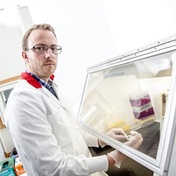Each year, thousands lose fingers, hands or entire limbs in terrible accidents. Prosthetics can help amputees regain some function, and successful hand transplants have recently been achieved. But wouldn't it be great if humans could simply re-grow missing parts on their own?
Within the space of a generation, this seemingly superhuman power might become a reality, scientists say, and people may have a lowly amphibian to thank for it.
Among the world's varied creatures, a Mexican salamander called the axolotl appears best at re-growing whole limbs lost to injury. And researchers are hot on the trail of finding out what the axolotl has that humans don't.
"The crux of what we are doing with this work is to be able to understand the basic biology of regeneration, and then translate that to regenerative therapies," said one pioneer in the field, biologist David Stocum, director of the Centre for Regenerative Biology and Medicine at Indiana University in Bloomington.
His team got a little closer recently, reporting on a key piece of the axolotl regeneration puzzle in the journal BioMed Central Biology.
How the study was done
Stocum's group found that a cellular protein called EVI5 appears to give cells at the wound site time to regroup and specialise, so they can produce the varied tissue types needed to re-grow an amputated limb.
As Stocum points out, humans do have a very limited capacity to re-grow complex tissue -- namely the fingertip. That's no small feat in itself. "The fingertip has got bone, there's also tendon there, and nerve tissue," Stocum said. "And the nail is a modification of the skin epidermis. [The fingertip] is pretty complex tissue."
Still, that's as far as it goes for regeneration in mature humans. Other animals can re-grow complex segments of themselves (many fish re-grow lost fins, for example) and the common frog has potent regenerative powers as a tadpole but loses them mysteriously as it matures.
Stocum's work with both the axolotl and the frog have turned up interesting clues to regeneration. In the salamander, the site of amputation does not close over with scar tissue as it does in most other animals. Instead, a bump of cells called a blastema forms at the injured area.
What the research revealed
The cells that collect in the blastema don't just go in one direction, forming scar tissue. Instead, they huddle and undergo a process called "de-differentiation," whereby each cell becomes oriented towards a particular disparate tissue type needed to replace the salamander limb -- bone, muscle, nerves. This process relies on a complex chain of interconnected biochemical signals, most of which remain mysterious, Stocum said.
But one key player has now emerged: the EVI5 protein, which appears to put the brakes on blastema cell division until proper cell de-differentiation is complete. In essence, Stocum said, high levels of EVI5 tell the wound area to "wait until you have made a little pile of blastema cells before you start dividing."
There's no guarantee that a similar system would work in humans, however. For one thing, "it's pretty well known that fingertip regeneration does not take place by the formation of a blastema like it does in a salamander," Stocum pointed out. As for the salamander, many more ingredients in the regeneration cocktail still need to be figured out.
Right now, Stocum's team is busy comparing regenerative processes in the axolotl to those found in the tadpole but not in the mature frog. "That will give us a handle, we hope, on why the frog loses the power of regeneration" and the axolotl does not, he said.
Regeneration of limbs 'possible'
Another expert agreed that the journey to helping humans re-grow lost body parts is just beginning. Dr Stephen Badylak, said that a close look at the axolotl is crucial, because "we need to identify what [the human] deficiencies are and then say, 'Is it possible for us to do something like that or not? Do we even have it in our genome?'"
Badylak, incoming president of the Tissue Engineering and Regenerative Medicine International Society and director of tissue engineering at the University of Pittsburgh's McGowan Institute for Regenerative Medicine, is optimistic that the regeneration of human fingers or limbs "is possible." But he added, it may be decades before that happens. In the meantime, regenerative medicine should make smaller but still valuable medical gains, he said.
For example, Badylak's group is now working with the US Department of Defence to develop better, scar-free wound healing for soldiers. And he believes that scientists are well on their way to re-growing body parts with simpler structures, such as heart muscle or organs such as the kidney.
"We'll figure out that stuff before the really complex stuff," Badylak said. "A finger, an arm, a hand -- those are extraordinarily complex body parts."
Stocum agreed that smaller discoveries will inevitably precede larger ones. In the meantime, he said, bioengineers are creating better and more sensitive prosthetics for today's amputees -- devices that would have been unimaginable even a few years ago.
Still, Stocum admitted, "nothing does beat the real thing." - (HealthDay News, January 2010)




 Publications
Publications
 Partners
Partners










